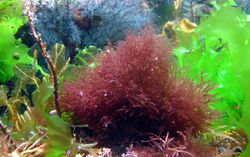Difference between revisions of "Pollution and algae"
From Coastal Wiki
| Line 1: | Line 1: | ||
| − | [[Image:Champia_parvula.jpg|thumb| | + | [[Image:Champia_parvula.jpg|thumb|left|250px| <div style="text-align: center;"> |
Champia parvula © Ignacio Bárbara | Champia parvula © Ignacio Bárbara | ||
</div>]] | </div>]] | ||
Revision as of 13:37, 22 July 2009
Algae are known to accumulate both metals and organochlorine compounds. [1] Heavy metals can depress algal growth when they are present above a certain threshold level. They can also destabilize their cell membrane. This inhibits the cell division or causes the algae change shape. [2]
Organochlorine compounds can also inhibit photosynthesis and algae cell growth. However, there seems to be a wide range in the tolerance of algae towards these compounds. Therefore the compounds might be a threat to the algae biodiversity and seasonal cycles of algae. [3]
Case studies
Case study 1:PCBs and organochlorine pesticides in Antarctic algae[4]
References
- ↑ Elliot, M.; Hemingway, K. (2002). Fishes in estuaries. Blackwell Science: London, UK. 636 pp.
- ↑ Md. Shahidul Islam and Masaru Tanaka, 2004, Impacts of pollution on coastal and marine ecosystems including coastal and marine fisheries and approach for management: a review and synthesis, Marine Pollution Bulletin Volume 48, 7-8 Pages 624-649.
- ↑ https://kb.osu.edu/dspace/bitstream/1811/5666/1/V72N01_006.pdf
- ↑ Joiris, C.R.; Overloop, W. (1991). PCBs and organochlorine pesticides in phytoplankton and zooplankton in the Indian sector of the Southern ocean. Antarctic Science 3: 371-377
